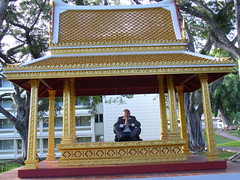The anniversary for the June 4th movement in China is just about here, once again shining a light on China’s progress in the human rights area in the last 20 years. While the New York Times publish weekly articles about China’s impending doom from censorship, and others continue to focus on China’s brainwashed population which doesn’t understand the concept of human rights or democracy (nor do they care), I think the picture is obviously more complicated, and in fact, a lot of China’s current protest and the government’s baby steps in freedom of speech can be seen online.
I read an article in the 苹果日报 (one of Hong Kong’s more politically driven newspapers) about Zhang Shijun, a former member of the PLA who was one of the “oppressors” in the June 4th movement. After his experiences on June 4th, 1989, he tried to retire from the PLA, but was refused and was labeled a “capitalist.” He was then further persecuted in the 1990s for being an anti-socialist and working against the party. He then tried to demand compensation from the army and further inquiry into his treatment. Now, in light of the 20th anniversary, he decided to use a different arena to demand “justice,” and on his own blog he explained his horror and disgust at the sight of students laying in their own blood, and others’ participation in the process. More than that, he encouraged other members of the PLA to step forward and admit their wrongdoings, and has even put his own name, identification number, and phone number on his blog, thus encouraging debate and frank discussion.
While his blog is currently blocked by the firewall, the fact that he is posting it shows some of the cracks in the firewall, and also shows that his case may not be a priority (it also may show incompetence, see for example China’s current battle with the grass mud horse). Similarly, another blog frequented by China’s intellectuals, Tienyi, has not been shut down, though it would seem that a lot of the discussion on the blog could possibly hit a nerve. A friend of mine discussed on his Huffington Post blog that, in reference to the Yang Shiqun incident (see, for other opinions concerning this issue, this other post), that we can see real differences in the way that the Chinese are using the blogosphere to have really frank discussions about human rights, the government, and other “taboo” issues.
I heard a lecture once that says that we need to look at China’s human rights record as a “movie rather than a picture,” meaning that we have to look at progress rather than just criticizing the current situation. China continues to do things that stir up local and international frustration about China’s censorship, but that is not the whole picture. We also cannot continue to compare China to other countries in the world. And while we have to perhaps search for such examples, there is a fair amount of discussion and criticism going on, even under the eye of sometimes reactionary Chinese censors. Perhaps the internet will be the new public sphere, where an online community (rather than a print community) will work towards progress in China.




